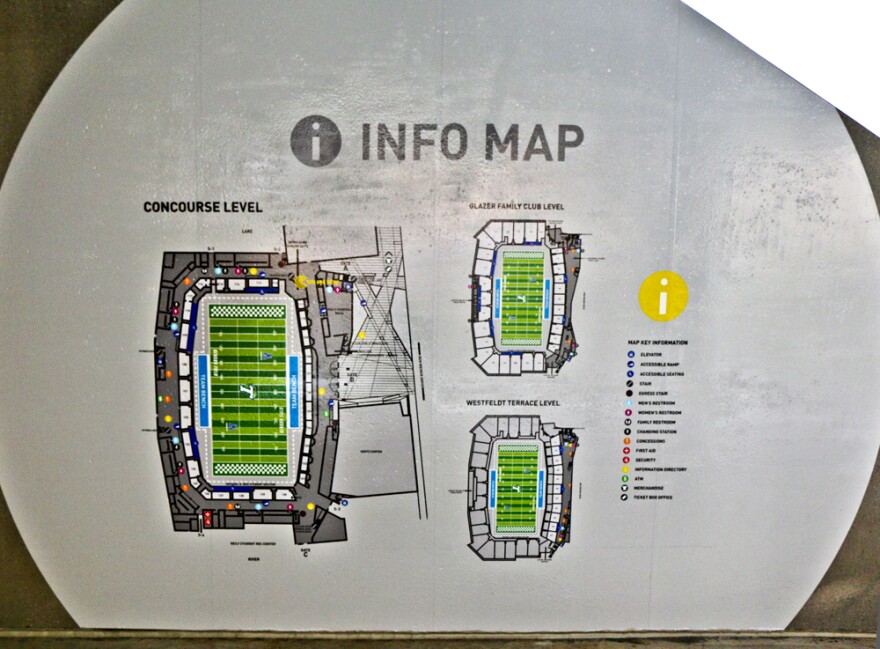What happens when you combine the most popular sport in the U.S. with one of the most dire environmental situations in the country? The catchy analogy that a football field sized piece of Louisiana coastal wetlands is lost every half-hour.
110 million people tuned in to the 2014 Super Bowl. Sandwiched between $4 million commercials from Budweiser, Chrysler and Doritos was something a little less expected, but certainly football related. The America’s Wetland Foundation paid for a commercial about coastal wetlands degradation that began: “An American treasure is being lost. Louisiana loses a football field of land every hour to coastal erosion.”
For more than a decade now, the Louisiana based non-profit America’s Wetland Foundation has been marketing their message about coastal wetlands loss wrapped in a sports analogy. The football field metaphor is the brainchild America’s Wetland Foundation director Val Marmillion. “Everyone knows the size of a football field, whether you like football or not,” he says.
Now it’s hard to find a story about Southeast Louisiana’s wetlands that doesn't reference Marmillion’s football field. He says he considered using basketball courts, too. “Louisiana loses 35 square miles a year, then .00176 square miles equals a basketball court, and 35 square miles equals 198,863 basketball courts, and 54 basketball courts in 24 hours, divided by 24 hours a day, is 2.25 basketball courts an hour that we're losing.”
198,863 basketball courts of wetlands loss every year is not catchy. But the football field analogy has caught on, and it's in line with the science overall. But if you’re imagining a football field right now, don’t. What’s being lost every half hour or so is a few inches here, a few inches there. Over time that approximates 50,000 square feet spread out over Louisiana’s Gulf Coast.

Nobody is more familiar with 50,000 square feet than John Lange, the game-day manager for Tulane University’s Yulman Stadium, where the Green Wave play football. His job is to walk the field on a regular basis.
“You’re talking about an actual playing field 160 wide by 360 ft. long," he says. "It’s amazing, you say you’re gonna lose this amount of coastline in 30 minutes.”
Standing at the 50 yard line, Lange says he likes this visual for what’s happening down the coast. “It’s unobstructed, it’s a clear view. You can really give that overall high level perspective of exactly what’s disappearing in a 30 minute period.”
About an hour and a half south of Yulman Stadium, in Theriot, another expert of sorts has a front row seat to wetlands loss.
“I’m the Bayou Woman!”

Wendy Billiot, is the real name of this Bayou Woman. She worked in off-shore oil for years, and now charters boat tours around Terrebonne Parish, including a firsthand look at disappearing wetlands. Her office and home sit on Bayou Dularge, where subsidence has caused the dock for her boat to separate from the shore.
“I challenge you to look on a map and see, there's everything but land down here.”
Billiot pores over a map from the perch of her office, which sits on 8-foot-high stilts. Billiot’s not a fan of the football field-a-day measurement. She agrees it’s easy to understand, but that’s also her problem with it. She’s got her own visual for wetlands loss she likes to use, “since we've been charting our wetland loss, we've lost a landmass area the size of Delaware — that you can wrap your head around.”
Billiot says she also takes issue with a common assertion that 35 square miles of wetlands are lost every year along Louisiana’s coast. She says that used to be true, but now it’s more like 18. “Does that mean that we're losing our coastline at a slower rate, or does that mean there's less to lose? There's less coastline to lose.”
So there are fewer square miles lost a year, but that means the problem is getting worse, not better. Billiot’s wetlands tour includes the specific deadly sins of coastal wetlands loss: “hydrologic modification is one, saltwater intrusion is another, erosion is another, eutrophication is another.”
America’s Wetland Foundation’s Val Marmillion prefers to bring the list of causes back into the sports arena. “We always say we're experiencing a trifecta right now, which is subsidence, sea level rise, and the trapping of the freshwater and sediments and nutrients that would grow a healthy marsh.”
Whether it’s seven deadly sins or a trifecta, football fields or Delaware, people working on coastal wetlands loss want to capture a broad audience. To make sure there’s public support for protection and restoration efforts. To find new sources of funding. And while this environmental issue isn’t likely to get its own version of a sports page, effective metaphors at least keep it in the news.

Support for WWNO's Coastal Desk comes from the Walton Family Foundation, Kabacoff Family Foundation and Greater New Orleans Foundation.



